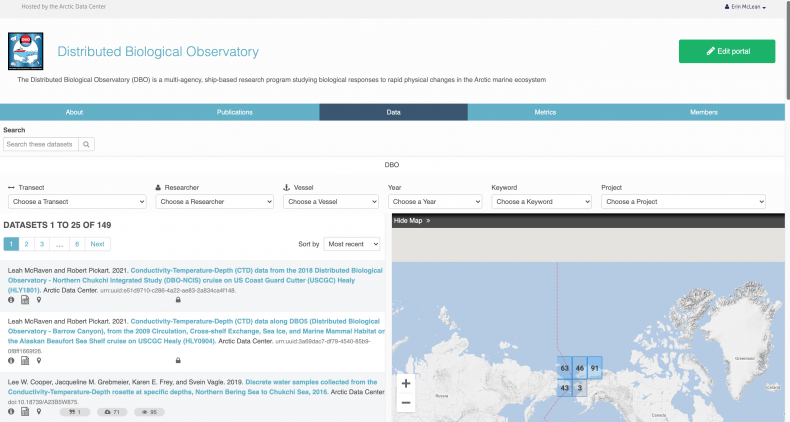The author(s) will give a talk
Profile curated collections of data with portals on the Arctic Data Center
1 Arctic Data Center/UC Santa Barbara
2 Arctic Data Center/UC Santa Barbara
3 Arctic Data Center/UC Santa Barbara
4 Arctic Data Center/UC Santa Barbara
5 Arctic Data Center/UC Santa Barbara
The COVID-19 pandemic has made it even more difficult for Arctic researchers to do their work; instead of facing the usual obstacles associated with field work in remote locations, researchers have had to cancel field seasons due to global restrictions around limiting the spread of COVID-19. However, research can continue through the reuse of existing datasets that have been archived in repositories like the Arctic Data Center, where all data is available for download and reuse. Comprehensive metadata make discovery of relevant datasets easy, enabling new synthesis research or analysis. Now, the Arctic Data Center has made it even simpler to navigate the catalog and customize the datasets shown through portals.
With portals, researchers create an environment where a collection of datasets and project information is available in a single location. Typically, a research project’s website won’t be maintained beyond the life of the project and all the information on the website that provides context for the data collection is lost. By creating a portal through the Arctic Data Center, researchers can both increase discovery of a curated set of related project data and preserve information on the project’s objectives, scopes, and organization. Coupled with the data files, these portals will support data use and interpretation for years to come. Since researchers are typically interested in a subset of the Arctic Data Center’s 6000+ datasets, portals help them see all relevant datasets in one convenient webpage (Figure 1).
Using the portals service carries a number of benefits for research projects or distributed teams:
-The discovery interface works like the main search catalog on the Arctic Data Center and includes an interactive map that scrolls and zooms to focus the data search to a particular region
-Customized search fields can be created that help narrow down the data search to specific metadata fields like Research Vessel or Field Site
-Portals can be branded with logos and colors and has a customizable URL
-Additional information on team members, associated publications, and essential details about the project or lab can be added using a user-friendly interface and customized using Markdown
-Collating metrics all in one place
Portals make highlighting and sharing related datasets easy for researchers, projects, and labs. 35+ groups have already taken advantage of the portals, with subjects ranging from oceanography to social science to field stations. Researchers can start creating portals today by logging in with their ORCiD even if they have not yet submitted data to the Arctic Data Center.
Distributed Biological Observatory Data Portal. 2021. http://arcticdata.io/catalog/portals/dbo
Toolik Field Station Data Portal. 2021. https://arcticdata.io/catalog/portals/toolik

Fig 1.
The data page of the portal created by the Distributed Biological Observatory, collecting all the datasets relevant to their work as a ship-based research program studying biological responses to rapid physical changes in the Arctic marine ecosystem.